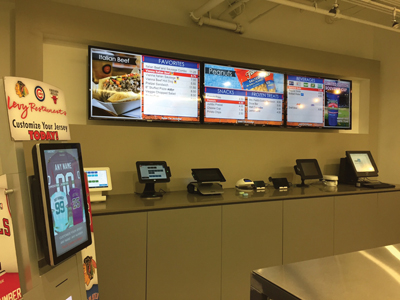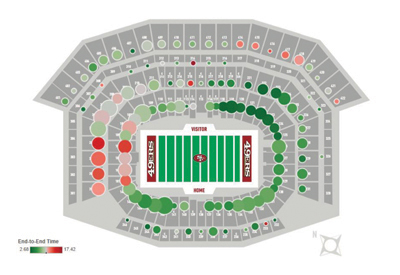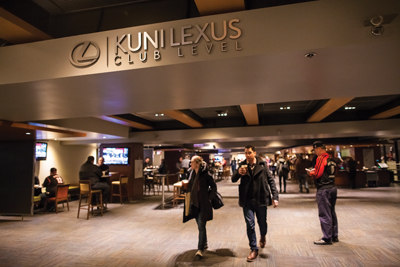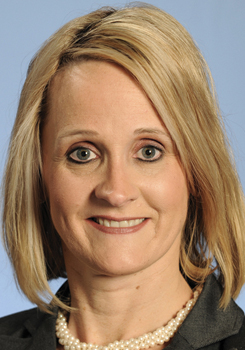On the fifth floor of Levy Restaurants’ office in downtown Chicago, a roomful of high-tech devices showcases the newest trends in food service technology: point-of-sale tablets, self-serve kiosks and video cameras that can track wait times for concession stands.
For Levy, the tech lab is like a miniature Apple store for clients, who can touch and feel those items and sit in on workshops explaining the technologies.
The displays and workshops are part of the E15 operation, the new analytics group Levy formed in August as a wholly owned subsidiary to help teams interpret data and drive new revenue through the information they glean from customer transactions in arenas and stadiums.
 |
Levy Restaurants’ E15 operation uses a room at its downtown Chicago offices to showcase the trends in technology that are bringing new approaches to food service and providing vital data on consumer habits.
Photo by: Levy Restaurants |
The emphasis E15 and other food vendors internally place on analytics underscores how big data is being used to study what fans eat, drink or buy to wear. More teams turn to their concessionaires to help them make sense of all this information and put it to good use in their buildings.
Those applications include:
■ Engineering digital menu boards with clean, attractive images of food and drink options to make it easier
and faster for fans to place their orders, with the ability to apply dynamic pricing late in the game to cut down on food waste.
■ Attaching video cameras with heat mapping technology above concession stands to analyze operations and make adjustments if necessary to cut down on wait times and streamline the overall process for food delivery.
■ In the suites, providing programmed tablets for patrons to give them the freedom to control their experience by ordering food and drink on their own and paging attendants when necessary.
■ In general, using data effectively by helping teams develop a mobile strategy for in-seat delivery, adding self-serve kiosks to order food and merchandise, and install mobile payment systems such as Apple Pay.
Levy is poised to take it one step further with its new division. E15 — named for phosphorus, the 15th element on the periodic table and used to light fire — has analysts across the country ready to crunch the numbers for Levy’s accounts. The service is free for Levy’s clients.
“We like to say if data is the fuel for business, then E15 is the spark that will ignite that for you,” said Jaime Faulkner, the company’s CEO.
Levy Restaurants isn’t the only concessionaire getting proactive on the big data front. Three years ago, Aramark started promoting its data-mining capabilities through a new company tag line, “Insights to Impacts,” a strategic tack for gaining new business through its back-of-house systems.
Others have been doing the same thing more quietly, such as Delaware North Sportservice and its base operation at
TD Garden. The Boston arena owned by its parent company serves as the vendor’s beta site for testing new technologies and the data generated from those systems.
About two years ago, Sportservice put a name to its analytics and consumer research initiative, a program called Total Listening. It covers the data collection piece and helps teams organize focus groups with the goal to improve the fan experience at their facilities.
The data gained from those insights led to Sportservice testing a kiosk at the 2015 NHL All-Star Game in Columbus where fans could self-order merchandise to be delivered to their homes a few days later.
“The thing that’s changed is the client side and making that data available,” said John Wentzell, president of Sportservice. “We have a range of non-users to robust users in our portfolio, but the list of clients wanting access to transactional data to feed their systems is growing and growing.”
Another ‘department head’
As teams and food providers connect the dots on their dashboards, they’re working together closer than ever to consolidate data from all sources at the venue to develop a complete 360-degree view of their customers.
In a few cases, concessionaires and teams remain protective of their financial and customer sales information and resist sharing data, “but those walls are coming down quickly” as they recognize the mutual benefits, said food consultant Chris Bigelow.
 |
Real-time data at Levi’s Stadium is used to spot trouble areas (shown in shades of red) with in-seat delivery.
Photo by: San Francisco 49ers (2)
|
In general, though, the relationships have evolved to the point now where the concessionaire essentially has become another “department head” for the team as they share information helpful for both parties, Bigelow said.
“We’re very much rooted on being transparent with our data,” said Aramark President Carl Mittleman. “If we just try to understand what the food and
beverage purchase means, we’re missing a big piece of the pie.”
In Chicago, E15 officials say their business model goes beyond food and
beverage by having their analysts gauge data connected to teams’ retail, ticket salesand corporate sponsorships, even player performance evaluations.
Providing those services helps Levy’s partners improve their end-to-end fan experience whether it’s through a smarter guest satisfaction program or customer segmentation strategy, Faulkner said.
“We get involved with a lot of the members of the front office,” Faulkner said. “I want our guys to be sitting next to the CFO or head of ticketing when we’re trying to understand what decision they’re trying to make or when we’re trying to explain the methodology to support our recommendation.”
The Portland Trail Blazers, a Levy client since July 2013, are one of the few teams to date that have gone deep with E15 to upgrade the food service at Moda Center with an eye toward eventually using its experts to improve other aspects of the team’s core business.
 |
The Portland Trail Blazers have used findings from Levy’s E15 division to revamp the club level at Moda Center.
Photo by: Portland Trail Blazers |
“We’re moving in that direction with Levy for sure,” said Vincent Ircandia, the Trail Blazers’ vice president ofbusiness analytics. “It’s mostly conceptual right now but we do have a timeline going forward where we layer in all these data sources. It’s going to help us across the business.”
Early in the process with E15, the Blazers are starting to see results on the food side. The former Rose Garden has moved up into the NBA’s top eight teams in arena per caps this season after placing in the top half of the 30-team league in past years.
Overall, the food numbers project to a 6 percent increase in the average spend for the 2014-15 season, effectively rising to 10 to 12 percent when layering in the cost savings from reducing food waste tied to an old all-inclusive buffet program, Ircandia said.
The revenue bump is due in large part to a revamped club level that switched from the buffet setup to a more traditional concessions environment tied to a loaded ticket with $30 in stored value.
The change on the club level for 1,800 premium-seat holders came after a fan survey the Blazers conducted in tandem with E15. The results showed those patrons saw value in the buffet and getting their food quickly. But they also wanted more variety with local brands and freshly prepared foods.
The Blazers knew that it would not be possible under the old food program to meet their patrons’ requests for freshness and a local slant, which E15 pointed out in the survey as the real drivers for customer satisfaction. Things had to change for upgrading the club-level food operation.
“We developed a couple unique Levy concepts and partnered with some Portland restaurants,” Ircandia said.
“People are happier now, customer satisfaction scores have really increased, and we’re reducing food spoilage.”
Apart from the club level, the arena’s new NCR Quest point-of-sale system has been critical to the data-mining process. The Blazers selected the hardware on their own given Levy Restaurants uses multiple point-of-sale vendors across sports and can’t play favorites.
E15, through its Levy Restaurants connections, has shown its expertise in Portland for quickly identifying data trends, especially in the NBA, where Levy runs food for about two-thirds of the league’s teams, Ircandia said.
“The big challenge in this age of big data is pulling insight from the vast amounts of data we are now collecting,” he said. “E15 helps us dissect this data [and] bring trends to life for us in real time. We can make adjustments to improve things and not wait to make a decision when it’s too late.”
Bigelow, the longtime consultant many teams hire to help pick the right food vendor for their facility, has seen the big data movement escalate in recent years. He says it’s just as important for food vendors to properly train their workforce to know the menu and keep the condiment stands clean and stocked as it is to cut wait times through new technology to ensure a quality fan experience.
“My feeling with the entire big data craze is that both teams and concessionaires have to show me the positive changes they are making in their operations based on this information gathering,” Bigelow said. “It’s no different than the iPad ordering in restaurants; does it make the food taste better? Because it certainly diminishes the human contact with the server, which is not a positive move unless the service was so bad to begin with.”
No longer just intuition
For Aramark, the escalating role data and mobile technology play in its operations drives the redesign of concession stands at Soldier Field in Chicago, where the concessionaire has managed food service for the Bears over the past two seasons.
In the summer of 2013 when Aramark first took over, the vendor eliminated all fixed cash registers and installed a new Micros point-of-sale system tied to 500 tablets. Its cloud-based platform sends real-time alerts to concession managers to replenish stands low on inventory, among other features.
For its first year, Aramark converted a grill stand on the main concourse to the DMK Burger Bar, a partnership with a popular local restaurant that quickly became Soldier Field’s top seller. For the 2014 season, officials expanded the burger concept to the club level, using data collected from the original stand to design and build the second location.
The key was the system’s flexibility for “line busting,” the term vendors describe for taking the tablets outside the stands to take orders and cut long lines. The technology led to design tweaks of the new stand for greater efficiency.
“In year one, we learned a ton about timing, placement and having the right products,” Mittleman said. “Five to seven years ago, we would go on intuition; we have to be faster, let’s try this.
“Here, we use the data to say, ‘Look, in the first 45 minutes, this is the peak and valley. Here’s your second 45-minute mark. What can we do to address pinch points?’ The outcome on the club level essentially shifted gears as we got into more and more data.”
Separately, Aramark brought hard liquor sales to Soldier Field’s public concourses in 2014 after aggregating the data from the eight other NFL stadiums where it sells spirits in general concessions.
In Chicago, by sharing those numbers with the Bears, the vendor made a strong case for expanding spirts beyond the premium level to the public areas, Mittleman said. It paid off. Aramark’s hard liquor sales in the NFL, including Soldier Field, grew by 9 percent last season over 2013.
“It may not sound like rocket science, but again, five to 10 years ago, it was all about what we think we need,” he said. “This is all data driven.”
Breaking down the numbers
Dan Marmion
Technology director, Delaware North Sportservice
■ What the field of analytics offers the concessions business: It’s evolved into deeper, more impactful insights, including predictive. Now, with more sophisticated systems and analytical tools that allow us to bring in “outside” data points beyond just food and beverage, we understand and model the relationship of weather, opponent, day of the week, game-day promotions and how they affect operational needs [and] financial performance.
■ A recent finding that has surprised you: The tools have helped with proving, refining and disproving our intuition while supporting the addition of more data to extend our knowledge regarding our business. The “ah-hahs” are big and small but helped us improve our optimized range of beverage sizes in certain types of stadiums and how we drive incremental spending in retail stores through certain promotional pricing.
■ Data asked for most often: It runs the gamut … from product skews, pricing and volume, to transaction times and method of pay.
Amy Cross
Chief information officer, Aramark
■ What the field of analytics offers for the concessions business: Analytics provides a wealth of information to help us better serve guests and deliver hospitality experiences that ultimately make their in-venue visit more enjoyable.
■ Data asked for most often: Spending activity in relation to location in the ballpark: Where are fans sitting vs. where are they buying? Also, spending activity in relation to time of game, MLB in particular: When during the flow of the game are fans buying?
Jaime Faulkner
CEO, E15/Levy Restaurants
■ A recent finding that has surprised you: One of the most interesting studies we have looks at the impact of teams’ winning or losing on fans’ discretionary spending at the venue, or per cap spending. While winning is a significant per cap driver for some teams, for many, we’ve found it isn’t as relevant as factors like the number of TV timeouts per game, percentage of tickets sold on the secondary market, and game-score differential.
■ Data asked for most often: Data that sheds light on the impact of corporate sponsorships, particularly beer deals, on food and beverage revenue is a common request. And we’ve had several questions from teams on the impact of craft beer programs specifically. Conventional wisdom says that craft beer drinkers pay more and drink less. However, analytics shows they actually pay more and drink just as much.
Bob Pascal
Chief marketing officer, Centerplate
■ What the field of analytics offers the concessions business: There’s traditional transaction-level data regarding service times, what items are ordered when, and in which location that are important so we can adjust offerings, staffing and promotions to drive spending and guest satisfaction. But what most excites us is the potential to capture and understand information about individual guests to further tailor our approach.
■ A recent finding that has surprised you: Centerplate has extended its services to Europe [and applied data capture] to understand the differences in fan experience expectations by country, region, sport and audience segment. In a recent study, we saw that the business community in a particular city was more pessimistic regarding the economy than consumers. So, from a program perspective, we need to think about the value of our offerings on the premium level to an even greater degree than the concourses because we’re catering to a business crowd in the suites and clubs.
■ Data asked for most often: We are still primarily asked for transaction-level data, but that will begin to change, to get at the “why” in addition to the “what” of attendance and spending patterns.











